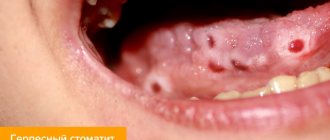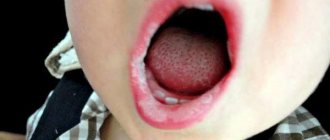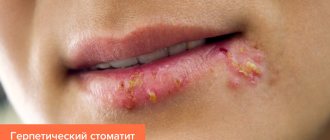Signs of stomatitis in children
To identify the cause of the child’s nervousness and capricious state, he must be carefully examined. The disease may not appear externally, so you need to examine the oral cavity, feel the tummy, and put your hand to the head. The first reason for refusing to eat may be the presence of small wounds in the oral cavity. A disease such as stomatitis exhibits similar symptoms.
The first signs of the disease can be recognized even without medical education: the tongue becomes covered with a white coating, as does the entire oral cavity. The presence of sores on the inside of the cheeks, lips and palate can cause a rise in temperature. If you notice such symptoms, you should immediately consult a doctor for help. A dentist can diagnose the disease and prescribe treatment. It is recommended to first consult with a pediatrician, who can indicate effective methods and methods of treatment.
In children, stomatitis can occur suddenly due to several reasons that contribute to the development of infection. When an inflammatory process appears in the oral cavity, the child will experience severe pain when trying to eat. The causative agents of this disease are different types of bacteria:
- Candida mushrooms;
- Allergic stomatitis;
- Herpes virus.
Symptoms
At the beginning of the disease, stomatitis is confused with ARVI and sore throat, as the child’s body temperature rises and a sore throat bothers him. Then the baby refuses to eat. A little later, drooling begins.
Symptoms of viral stomatitis in children fully manifest themselves by the third day of illness.
The following rashes appear in the oral cavity:
- erosions - these include areas of the mucosa devoid of surface epithelium, they are accompanied by severe burning and itching;
- bubbles - they are located on the inner surface of the cheeks, under the tongue, on the palate, a transparent secretion accumulates inside them;
- ulcers are defects in the mucous membrane, covered with a gray coating or films, sometimes they bleed, and the mucous membrane around them is swollen.
In the mouth you can see a white-gray coating and swelling of the tongue. The mucous membrane is red and swollen.
The baby's general symptoms are increasing. He is worried about general malaise. He is whiny, restless, eats and sleeps poorly. The baby has bad breath. An increase in the submandibular and cervical lymph nodes is detected.
Inflammation of the oral cavity in a child: causes, treatment
Pathogenic bacteria do not select their hosts based on age; for them, the main factor is a beneficial environment. Children, as a rule, are more susceptible to this type of infection than adults, because... the body is weaker and does not have a strong enough immune system.
If a child has been infected with pathogenic bacteria, this does not mean that the parents are providing poor care; today, the risk zone for children is modern sweets, many of them may already contain strains of viruses, depending on where and by whom they are produced, and as a result, they can cause caries and other dangerous diseases. For example, as a result of an examination, a doctor can diagnose stomatitis.
We are talking not only about school-age children, but also about infants who feed on their mother’s breasts, since bacteria can also be transmitted through milk. Children aged from birth to three years old can suffer from candidal stomatitis. After three years, they may develop herpetic stomatitis. This occurs when a child is denied a pacifier and begins to suck dirty fingers, which leads to the spread of bacteria in the oral cavity and the formation of small ulcers in size and shape. In this case, stomatitis in children in the mouth can be dangerous and treatment must be carried out very quickly, since the child will not be able to eat food at all, which will negatively affect his general condition and activity, not to mention the terrible pain that the child will experience.
School-aged children may also be susceptible to oral inflammation. In them, the disease takes the form of allergenic or aphthozonal stomatitis. It should be noted that an unhealthy lifestyle, unsanitary conditions, dirty cutlery or lack thereof can lead to adults also getting stomatitis. When it comes to children, it is necessary to conduct preventive and educational conversations about the need to always take care of hygiene, because clean hands are a guarantee of protection against the occurrence of stomatitis and intestinal diseases.
Stomatitis is more common in children. This is explained by the fact that in babies the mucous membrane in the oral cavity is much more tender and thinner. This leads to its rapid injury and defeat. The child’s immune system cannot cope with a large number of bacteria, so wounds appear in the mouth, which are quite difficult to cure. At the initial stage, stomatitis in her child can be detected by the mother, who is always next to him. However, you should not experiment with treatment; it is important to identify the cause of the disease and undergo treatment. You can only take precautions by isolating the child in a separate room if there are other children in the family. The reason for isolation is simple: the disease is transmitted through airborne droplets.
How to treat aphthous stomatitis in children?
Before how and how to treat aphthous stomatitis in children, the child should definitely be shown to a specialist, since self-medication can result in the disease becoming chronic or developing complications. The doctor will conduct diagnostics and tests to determine the specific causative agent of the disease, and then prescribe adequate antibacterial therapy.
The complex also prescribes antipyretics, anti-inflammatory and vitamin preparations, and regular antiseptic treatments of the mucous membrane are carried out. The most commonly used antiseptics are chlorhexidine and hydrogen peroxide; in the past, brilliant green was often used. Some parents still believe that aphthous stomatitis can be treated with brilliant green, but in fact this is just one of the stages of therapy, and is considered outdated, since the alcohol solution additionally injures the mucous membrane.
“32 Dent” clinics provide all types of dental services, including treatment of stomatitis. The professionalism of doctors, coupled with high-quality equipment, guarantees excellent and sustainable results.
Treatment of stomatitis in children of different ages
Stomatitis in children is a kind of profuse inflammation of the oral mucosa. It is necessary to treat the baby immediately and avoid extensive lesions. The child needs to be provided with special hygiene products with which he can regularly rinse his mouth.
If the baby is still very small, then he should treat his mouth with special napkins, on which a special solution - an antiseptic - is applied. Children over one year old can easily learn to rinse their mouth after eating, clearing it of dirt. This rinse will allow the sores to gradually heal as all bacteria and infections are destroyed. If stomatitis is not treated promptly, ulcers can spread throughout the entire oral cavity. In the future, this will lead to diphtheria, which is much more serious than stomatitis.
If an infant gets stomatitis, it means that nipples and bottles need to be carefully treated. Also, before each feeding, the mother’s nipples need to be treated, since various infections can be transmitted through them. Everything must be clean and sterile. If the child eats independently, then you need to ensure that the temperature of the food is equal to body temperature. In this case, he will use it without whims and stubbornness. Sour foods or particularly spicy foods should be excluded from the diet. If it is too painful for your child to eat, you can offer him food through a straw. This can be broth or liquid puree.
If a child with stomatitis refuses to eat, it is possible that he experiences severe pain while eating. In this case, you can use special gels that reduce the sensitivity threshold, and the child can eat little by little. If stomatitis is detected in a child, treatment must be started immediately. Nowadays, childhood stomatitis can be successfully treated, and the treatment itself can be completed in just a few days if you regularly rinse the mouth and monitor hygiene.
Sometimes there are situations when stomatitis is accompanied by the appearance of another disease - periodontitis. Here, home treatment is not enough, since periodontitis in children is treated in a specialized dental clinic or hospital. These diseases can be treated by the staff of the Dent Prestige dental clinic. Experienced specialists will always come to the aid of children and their parents.
How does aphthous stomatitis occur?
Mouth ulcers appear on the 2-3rd day of illness1. Usually after 7-10 days they heal without leaving marks1. However, when the disease becomes chronic, a relapse may occur1. In this case, a few days or several weeks after healing, aphthae appear again, although in small quantities - from 1 to 31. Although ulcers are painful, general health is usually not affected1.
Chronic aphthous stomatitis can occur in different ways2, depending on the size, depth and number of aphthous stomatitis. The following forms of the disease are possible:
- Small. The most common type7, in which elements up to 5 mm in diameter appear on the mucous membrane of the lips, cheeks and floor of the mouth. Aphthae heal without scarring within 10-14 days7.
- Big. This form rarely develops. Its typical manifestation is large ulcers, the size of which sometimes exceeds 1 cm in diameter. Aphthae can be found on the lips, palate and pharynx. They last up to 6 weeks, and after healing, scars remain in their place7.
- Herpetiformis. It is characterized by the appearance of many ulcerations with a diameter of 2-3 mm, which can merge7 (as is observed with herpes3). Their favorite places are the floor of the mouth and tongue7.
In the acute form, the symptoms are very similar to a cold: a person’s body temperature rises, general weakness and fatigue bother him1.
to come back to the beginning
How to treat aphthous stomatitis
Without treatment, the disease can last for many years1. Therefore, if ulcers, pain and burning sensations appear in the mouth, you should consult a doctor. Only a specialist can make a diagnosis and select the optimal treatment regimen. Most often, these patients are managed by dentists, but a general practitioner or family doctor can also help.
Treatment of aphthous stomatitis should be comprehensive, that is, aimed at solving several problems at once8:
- Elimination of foci of infection in the oral cavity using drugs for topical and oral administration8.
- Stimulate healing and support immunity . Wound-healing drugs, immunomodulators and antihistamines, as well as vitamins and micronutrient supplements are used8.
- Treatment of underlying diseases that contribute to inflammation of the oral mucosa, for example, diseases of the gastrointestinal tract and upper respiratory tract8.
During therapy, it is necessary to adhere to a gentle regimen - avoid spicy, rough foods and alcohol, as well as dentures if they injure the mucous membrane8.
To fight the infection, the doctor may prescribe topical medications - antiseptic and antibacterial10. Among them there are also combined agents, such as Metrogyl-Denta®9.
METROGYL DENTA® is a gel that contains metronidazole, which has an antibacterial effect, and the antiseptic chlorhexidine9. This combination can inhibit various types of bacteria and fight infection9.
METROGYL DENTA® is widely used in dentistry; it is approved by the Russian Dental Association11 and is indicated for the treatment of aphthous stomatitis9. The duration of treatment, dose and frequency of use is determined by the doctor, depending on the degree of damage and severity of the disease.
to come back to the beginning
Symptoms of stomatitis in children
The first symptom of stomatitis in a child that can be seen by relatives is dry, flaky lips. A small white coating may form on the tongue, which over time can spread throughout the mouth. Infants may well become infected with fungal stomatitis, which manifests itself in the form of small white spots. By their nature, the spots resemble milk that has curdled on the tongue. Sometimes such stomatitis can occur as a result of long-term treatment with antibiotics. That is why doctors do not recommend long-term use of such drugs.
An increase in temperature is one of the primary symptoms, which may also indicate that the child is sick. Lack of appetite, lethargy, whims - these are the first symptoms that need to be responded to in terms of diagnosing the oral cavity in a child.
Causes of aphthous stomatitis in children
The main causes of this disease are infectious lesions of the oral mucosa or individual allergic reactions that weaken the body’s defenses and provoke the development of the disease. Risk factors may include:
- Infectious diseases (staphylococcal infections, tonsillitis, influenza, diphtheria, adenovirus, etc.).
- Allergic reactions.
- Unbalanced diet with insufficient intake of vitamins C and group B, folic acid, as well as a number of macro- and microelements (zinc, iron, selenium, etc.).
- Anemia and diseases of the digestive system.
- Disturbances in the functioning of the immune system.
- Injuries to the oral mucosa, as well as insufficient oral hygiene in children.
Treatment of stomatitis using traditional medicine
Medical staff at children's clinics say that when stomatitis is detected, it is best to consult with your doctor. Only a specialist can identify what stage the disease is at and prescribe treatment. However, there are situations when the clinic is not open (for example, evening hours and night time), and the child is very sick and does not feel well. If stomatitis is detected at first, you can resort to traditional medicine. There is no need to think that the disease will go away on its own. If the infection is not eradicated, the child will get even more sick.
In case of stomatitis, the oral cavity should be wiped with a bandage containing a soda solution. Plaque in the mouth is removed with a bandage or a piece of gauze, thereby eliminating the infection. Making a soda solution is very easy: add one teaspoon of soda to one glass of water and mix thoroughly. Before use, the liquid should be stirred so that the soda does not remain at the bottom of the glass. Using soda, you can thoroughly disinfect the oral cavity and mucous membrane, while removing plaque.
You can also try wiping the inside with slimy brilliant green. Procedurally, you need to do the same as with a soda solution. Then soak in brilliant green and thoroughly wipe the child’s mouth.
For older children, you can prepare herbal infusions and give them a mouth rinse after eating. In this case, food particles will be removed, and the mucous membrane will not burst. You can rinse with a chamomile solution, which quickly removes the inflammatory process. It is not uncommon for people to use strong green tea, which is also used as a mouth rinse. This procedure should be carried out several times, and it is not at all necessary to do it after meals.
It is sometimes quite difficult to persuade young children to rinse their mouths, especially if they experience pain there. In this case, they may like rose syrup, which also has a positive effect on eliminating infections in the mouth. You can make this syrup yourself using rose petals, sugar and water. You can easily prepare a decoction of oak bark at home. Herbs you can choose from are burdock, sage, and yarrow. You can prepare a mixture of these herbs and rinse your mouth with the tincture several times a day.
You can also use aloe, which you can simply chew. If a child cannot swallow such a plant, then holding it in his mouth will be enough. Aloe will taste good together with a little honey. However, we must remember that using large amounts of honey for stomatitis can only worsen the disease. When a child is ill, you should use only high-quality products without acid and harsh sensations, which will not cause allergies and irritation of the mucous membrane. It is advisable to limit yourself to a set of dishes that were pleasant to the child and did not cause him discomfort.









